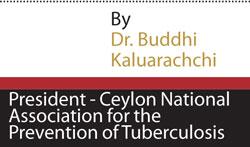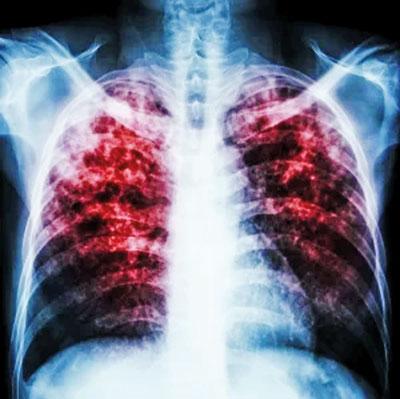Reply To:
Name - Reply Comment
Last Updated : 2024-04-20 00:00:00
 The World TB Day, observed on March 24 each year, intends raising awareness, imparting knowledge and providing motivation for action against tuberculosis worldwide.
The World TB Day, observed on March 24 each year, intends raising awareness, imparting knowledge and providing motivation for action against tuberculosis worldwide.
“Mycobacterium tuberculosis (TB) is infamous for many reasons, not least as the biggest infectious killer of all time. Dating as far back as the ancient Egyptian era, the disease is present in most countries. For some, the spectre of tuberculosis may seem relegated to the past, enshrined in 19th century books and plays. For others, however, the malady is all too alive, wreaking havoc in their bodies, families and communities. No matter how you view it, tuberculosis is one of the gravest health threats facing today’s world, and is all the more serious as drug resistance takes a grip” - Medicine sans frontiers MDRTB crisis alert. DR TB 2014.
131 years ago, following the discovery of Koch’s Bacillus, tuberculosis remains an epidemic out of control – despite the fact that efficacious remedies have been made available for decades. The greatest killer of human beings in history is still at work in spite of many
scientific breakthroughs.
Tuberculosis – appearing in many forms resistant to multiple drugs (MDR TB) that cannot be cured by effective medicine together with its deadly ally, the human immunodeficiency virus (HIV) – has emerged as one of the most potent threats to mankind and the biggest threat to the world economy.
Why cannot tuberculosis be eliminated? Very simply, it is due to low priority given to the malady by health policymakers. In low to middle income countries, less than 1% of the annual health budget is allocated for tuberculosis. For what is this silence? Is it because tuberculosis is something to be swept under the carpet?
This is because patients are not completely cured but do not die of the disease either, leaving a pool of inadequately or improperly treated patients disseminating multi-drug resistant tuberculosis in the community.
Compared to other South Asian countries, Sri Lanka is ahead in terms of quality of life, life expectancy and literacy maternal mortality. This is a constant source of amazement to developed countries that wonder how we maintain such indices
 However, all is not that gloomy. It has been shown conclusively in countries poorer than Sri Lanka, such as Nepal and Bangladesh (with per GNP of some USD 200 compared to a per capita GNP of USD 840 for Sri Lanka), that more than 90% of tuberculosis patients could be cured and the emergence of multi-drug resistant tuberculosis controlled if the treatment of tuberculosis patients were completely supervised.
However, all is not that gloomy. It has been shown conclusively in countries poorer than Sri Lanka, such as Nepal and Bangladesh (with per GNP of some USD 200 compared to a per capita GNP of USD 840 for Sri Lanka), that more than 90% of tuberculosis patients could be cured and the emergence of multi-drug resistant tuberculosis controlled if the treatment of tuberculosis patients were completely supervised.
NEW TOOLS, DRUGS AND STRATEGIES
DOTS Strategy (Directly Observed Treatment Short-Course)
This strategy represents a major breakthrough in controlling tuberculosis. No other TB control strategy comes close to being as effective and affordable as DOTS. The advantages of this strategy are numerous.
Implementation of ‘Stop TB strategy’
The greatly-expanded tuberculosis diagnosis and treatment service have saved millions of lives. The development of new tools is a major component of the revised global efforts to end TB. Progress has been made in this area. They are now in the evaluation process and will be incorporated into the TB control programme in the near future. New and powerful drugs for the chemotherapy of tuberculosis have also been developed and progressively introduced into the treatment regimen.
Systematic strategy for screening and monitoring high-risk zones
Where the population is concentrated such as – A) Garment Industries; B) Factories; C) Prison Institutions; D) Rehabilitation Camps; E) Elderly People’s Institutions; F) Orphanages; G) Mental Asylums; H) Low-income communities residing in congested areas.
Changing of campaign terminology strategy
Terms like TB suspects, defaulters and control are patient-unfriendly and tend to criminalize the campaign. Therefore, in the control of tuberculosis, consideration is being given to the use of terminologies which are more humane and patient-friendly thereupon making the patient more co-operative.
Greater involvement of NGOs in recruiting and mobilizing volunteers for treatment and supervision will make tuberculosis efforts more
effective and efficient.
The international community, WHO NGOs and the Sri Lankan Government have done a great deal for the prevention, treatment and management of the disease
Compared to other South Asian countries, Sri Lanka is ahead in terms of quality of life, life expectancy and literacy maternal mortality. This is a constant source of amazement to developed countries that wonder how we maintain such indices. The answer is, of course, the standard of literacy and education of the population, solid healthcare infrastructure and active NGOs.
Initiatives of Ceylon National Association for the Prevention of Tuberculosis (CNAPT)
It has been recorded that in countries poorer than Sri Lanka, such as Nepal and Bangladesh (with a per capita GNP of USD 200 compared to a per capita GNP of USD 840 for Sri Lanka), have successfully managed more than 90% of tuberculosis treatment.
This is where CNAPT steps in to educate the public in conducting awareness programmes which are important aspects of TB eradication. CNAPT has been at the forefront of the campaign for the education of Sri Lankans. Over the past 70 years, CNAPT has worked in partnership with the Health Ministry for diverse civil society partnerships to promote knowledge and understanding of the disease among the vulnerable strata of the population and to improve access to proper medical care.
In 1948, when tuberculosis was prevalent in Sri Lanka, CNAPT was formed as a government approved non–governmental organization (NGO) aimed at launching a nationwide TB programme via basic education, programme support and international co-operation. Some 70 years ago, when medical treatment was at its infancy and TB was rampant with no definitive cure, Colombo Rotary Club Chairman Dr. J.H.F. Jayasuriya sponsored a voluntary organization to combat TB through the auspices of the club. The inaugural meeting was held on June 17, 1948, thus heralding the
beginning of CNAPT.
In 2008, CNAPT with financial assistance from the Global Fund for TB and Malaria (GFATM) sponsored a Knowledge, Attitude and Practice (KAP) study to better understand the gaps in education and the lapses in public behaviour that obstruct national efforts in TB eradication.
This study was undertaken in collaboration with medical personnel attached to the Respiratory Disease Control Programme of the Health Ministry, Centre for Social Survey and Sri Jayewardenepura University.
With the intention of imparting knowledge on TB, its spread, prevention and management as well as to enlighten the public on how and where to seek help and information required, CNAPT with the assistance of the Global Fund started a health education programme.
The primary target group of this campaign was school teachers whose aim was to take advantage of their strategic position and spread the message to their pupils and through them to the society at large.
The international community, WHO NGOs and the Sri Lankan Government have done a great deal for the prevention, treatment and management of the disease. Help is available but people need to be informed from where they could seek assistance.
People need assistance and when we extend a hand, others will willingly grasp it. CNAPT aims at promoting the concept of extending a helping hand by seeking community, public and volunteer assistance. Tomorrow will be better only through our efforts.
Despite the achievements, many TB patients remain undiagnosed. Escalated community involvement coupled with the harnessing of related elements could be the answer to combating this lethal disease and CNAPT is committed to being a forerunner in fulfilling this objective.
Emphasis on research and development to improve knowledge and hone skills for diagnosis, treatment and prevention, plus expansion of existing methods, may facilitate CNAPT’s goals. The association has opted to educate the public through technical publications, workshops and seminars. This is how we
attempt to combat TB.
TB in children
Special hospital facilities were non-existent for children afflicted with TB. CNAPT remedied this by constructing three children’s wards – Welisara Children’s Ward (1952), Hawake Memorial Ward in Kandana (1955) and Clarence Nathanielz Memorial Ward in Welisara (1960) – which provided a total of 165 beds for children. A total cost of Rs.900,000 was raised through the efforts of CNAPT.
Health education
Since its inception, the association has concentrated heavily on health education. The objective of the programme was to convey to the public that TB could be cured, patients must take prescribed treatment and those with suggestive symptoms be screened. The programme also included lectures for targeted groups, talks via electronic media, participation in public exhibitions and distribution of TB related literature. The appointment of permanent health educators furthered this cause.
The proximity of the Health Education Centre to the Colombo Museum makes it accessible to any visitor of the museum who wishes to tour CNAPT’s Health
Education Centre.
Conclusion
Due to the rapid advancement of TB medical treatment, many functions of CNAPT have been made redundant and today, the association concentrates primarily on promoting health education.
The reduction in the duration of treatment from four years to six months has made it easier for patients to carry on with their everyday routines with the least amount of inconvenience and the stigma attached to TB has all but disappeared.

Add comment
Comments will be edited (grammar, spelling and slang) and authorized at the discretion of Daily Mirror online. The website also has the right not to publish selected comments.
Reply To:
Name - Reply Comment
On March 26, a couple arriving from Thailand was arrested with 88 live animal
According to villagers from Naula-Moragolla out of 105 families 80 can afford
Is the situation in Sri Lanka so grim that locals harbour hope that they coul
A recent post on social media revealed that three purple-faced langurs near t